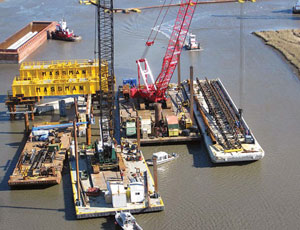Reducing flood risk on the Mississippi River delta is big business. The U.S. Army Corps of Engineers is working with a $14.3-billion appropriation to bring the Greater New Orleans Hurricane and Storm Damage Risk Reduction System to 100-year levels of protection by June 1, 2011.

This will be the busiest year so far, with more than 100 projects worth $3.2 billion scheduled for award. Included are 77 contracts for levees and floodwalls; 23 for pump- station repairs and improvements and 10 for urban drainage. “To give some perspective...understand that the Corps’ entire national program is funded at $5 billion,” says Karen Durham-Aguilera, director of Task Force Hope, which oversees the HSDRRS program. Of the estimated 350 contracts in the program, 138 have been completed, and 34, worth $1.4 billion, are ongoing.
To expedite, the Corps is conducting industry days, partnering sessions and innovation workshops with the contracting, architectural and engineering community and other stakeholders. It is using design-build project delivery, innovative contracting methods and special financial agreements.
In January, John Paul Woodley, assistant secretary of the Army for Civil Works, signed an agreement with state and local officials to take advantage of a rarely used law that lets the federal government pay the full $14.3-billion authorized amount upfront, giving Louisiana 30 years to pay its estimated $1.5 billion cost-share. “We have done that with water projects elsewhere, but never on this level,” Durham-Aguilera says.
By the 2009 hurricane season, Shaw Environmental and Infrastructure Group, Baton Rouge, La., is to deliver a 25-ft-tall, 7,490-ft-long braced concrete wall to help block storm surge from the east and fulfill a Corps promise to provide interim protection at what has been called the Achilles’ heel of the system: the confluence of the Inner Harbor Navigation Canal, the Gulf Intra-coastal Waterway and the Mississippi River Gulf Outlet. The full $695-million project, with operating gates for ship traffic, is scheduled for a 2011 completion. It is the single largest component of HSDRRS to date and the largest design-build civil-works project in the history of the Corps, and it may grow substantially larger, due to changes to navigation gates demanded by the shipping industry and U.S. Coast Guard. The Corps is performing value engineering and anticipates having a revised estimate by the end of March.
On April 10, the Corps expects to award another $500-million-or-greater contract for another surge-barrier project: the Gulf Intracoastal Waterway West closure complex. It will be larger and more complex than the IHNC barrier and includes an enormous 25,000 to 30,000 cu-ft/second-capacity pump station.
For this project, the Corps is proposing use of Early Contractor Involvement, which is also known as Contract Management at Risk (CM@R). ECI lets the Corps engage a general contractor for “pre-construction services” concurrent with design. It is a fixed-price incentive contract that allocates risk and gives the government an option with the pre-construction contractor to let the firm move on to construction.
| COMPONENT | $ MIL |
|---|---|
| Repair existing system | 1,126 |
| Restore to design height | 800 |
| Complete authorized system | 659 |
| Permanent pump stations | 804 |
| IHNC navigable floodgates | 1,203 |
| Selective armoring | 629 |
| Storm-proof existing pump stations | 340 |
| Incorporate non-federal levees inPlaquemines Parish | 671 |
| I-wall replacement | 1,626 |
| 100-year level of protection | 3,642 |
| SELA (Interior damage) | 1,538 |
| Fifth Supplemental: Restore and complete (LPV&WBV) | 1,300 |
| Total Appropriated funds: | 14,300 |
| SOURCE: USACE, NEW ORLEANS DISTRICT | |
“I first heard of ECI when it was used for the Olympic complex in Australia,” Durham-Aguilera says. “ECI offers advantages of real-time constructibility input.” The Corps plans to use ECI on other upcoming projects also.
With the abundance of work and speed of delivery required to meet the 2011 deadline, contractors are wondering if they will be able to keep up. “I’ve never seen multibillions of dollars of work in this area, so I don’t know what will happen,” says Jonathan Kernion, president of Cycle Construction, a New Orleans-based heavy civil contractor that has done Corps work for 30 years. “Everything is on a short fuse. I don’t know if the industry can handle it. Get it out there, and we’ll step up and see what we can do.”
Cycle Construction can handle more work than it has now, Kernion says, but labor and materials are always a challenge, depending upon supply-and-demand timing. “For materials, we can get quotations in advance, but dump trucks don’t work like that,” he says. “When demand increases, drivers start prostituting themselves for 25¢ more per hour.”
HSDRRS was more robust when Hurricane Gustav hit in 2008, and it will be even stronger by the 2009 season with advanced measures in place, Durham-Aguilera says. However, she cautions that safety will never be guaranteed, even in 2011, with the 100-year levels of protection in place. “No matter what we do, there will always be risk,” she says.



Post a comment to this article
Report Abusive Comment